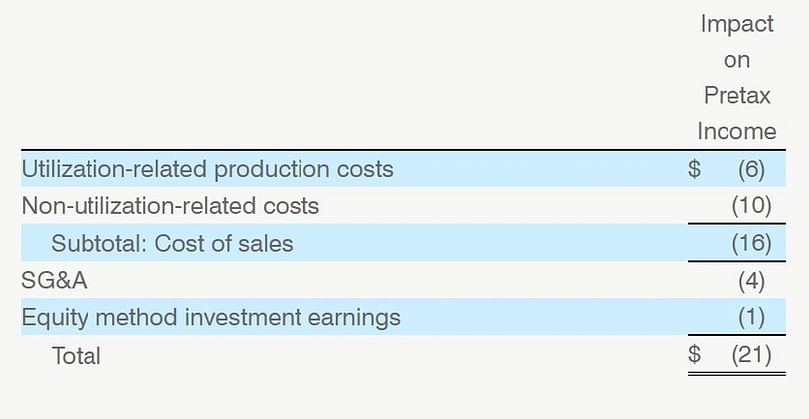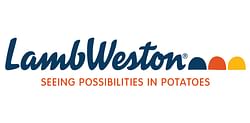Potato Processor Lamb Weston Reports Fiscal First Quarter 2021 Results; Provides Update for Second Quarter of Fiscal Year 2021
Potato Processor Lamb Weston Reports Q1 F2021 results and provides update for Q2

First Quarter 2021 Highlights
- Net sales declined 12% to USD 872 million Income from operations declined 20% to USD 136 million, and includes USD 20 million of costs, net of CARES Act
- benefits, related to the COVID-19 pandemic's impact on operations
- Net income declined 23% to USD 89 million EBITDA including unconsolidated joint ventures(1) declined 13% to USD 202 million, and includes USD 21 million of net
- costs related to the pandemic's impact on operations
- Diluted EPS declined 23% to USD 0.61
- Paid USD 34 million in dividends to shareholders
Second Quarter of Fiscal Year 2021 Business Update (for 4 weeks ended September 25, 2020)
- North America shipments at approximately 90% of prior-year levels, led by demand from quick service restaurants and retail, as well as continued recovery by full-service restaurants
- Europe, China and Australia shipments approaching prior-year levels Shipments to other Asian and Latin American markets lagging demand recovery as customers and distributors
- right-size inventories.
Lamb Weston Holdings, Inc. (NYSE: LW) announced today its fiscal first quarter 2021 results and provided a business update for the second quarter of fiscal 2021.
Tom Werner, President and CEO:
“We drove sequential improvement in sales and earnings this quarter, and are optimistic about the improvement in restaurant traffic in the U.S. and our key international markets.”
“While still below pre-pandemic levels, demand for our products in the U.S. stabilized during the latter half of our first quarter and into September as quick service restaurants rebounded, and as full-service restaurants were aided by the relaxing of government-imposed restrictions for on-premise dining, as well as increased carry-out and delivery traffic.”
“Retail demand for our branded products continued to be strong, although off the peak levels that we saw in the initial weeks of the pandemic. Pricing remains stable, with normal competitive dynamics in larger chain restaurant and foodservice contracts that are up for renewal.”
“During these unprecedented times, our priority continues to be the health and safety of our employees, and I want to thank the entire Lamb Weston team for their continued service to each other, and their commitment to working closely with our customers and suppliers as they manage through this challenging environment.”
“Our team worked to steadily improve our ability to control costs and manage through the pandemic's effect on our operations as the quarter progressed, although we expect that we will continue to experience some disruption and increased costs until the virus is broadly contained. Nonetheless, we remain confident about the long-term prospects for the category, as well as our ability to support our customers, and create value for our stakeholders.”

Summary of First Quarter 2021 Results (USD in millions, except per share amounts)
Q1 2021 Commentary
Net sales declined USD 117.5 million to USD 871.5 million, down 12 percent versus the prior year. Price/mix increased 2 percent, primarily due to improved price/mix in the Foodservice and Retail segments.
Volume declined 14 percent, reflecting the decline in demand for frozen potato products outside the home following government-imposed restrictions on restaurants and other foodservice operations to slow the spread of the COVID-19 virus.
The decline was partially offset by increased sales of frozen potato products for in-home consumption.
Income from operations declined USD 34.3 million, or 20 percent, to USD 135.7 million versus the year-ago period, reflecting lower sales and gross profit, as well as approximately USD 20 million of costs, net of estimated employee retention credits provided by the Coronavirus Aid, Relief and Economic Security Act ('CARES Act') and other labor incentives, related to the pandemic's impact on operations.
These pandemic-related costs include:
- Approximately USD 6 million of factory utilization-related production costs and inefficiencies, such as labor retention costs; costs to shut down, sanitize, and restart manufacturing facilities after a production employee was infected by the virus; costs arising from modifying production schedules and reducing run-times; and additional costs and inefficiencies related to manufacturing retail products on lines primarily designed for foodservice products;
- Approximately USD 10 million of non-utilization-related costs, of which approximately USD 3 million relates to expensing the remaining crop year 2019 contracts for raw potatoes that could not be used due to the pandemic's near-term effect on demand, and approximately USD 7 million of expense for enhanced employee safety and sanitation protocols as well as incremental warehousing, transportation and other supply chain costs; and
- Approximately USD 4 million of selling, general and administrative expenses ('SG&A'), largely comprised of costs to retain certain sales employees, net of CARES Act retention credits and other labor incentives.

Summary of First Quarter 2021 COVID-19 Pandemic-Related Costs ($ in millions USD)
Gross profit declined USD 34.8 million, driven by approximately USD 16 million of pandemic-related costs described above as well as lower sales. The decline was partially offset by a USD 5.0 million change in unrealized mark-to-market adjustments associated with commodity hedging contracts, which includes a USD 6.8 million gain in the current quarter, compared with a USD 1.8 million gain related to these items in the prior year quarter.
SG&A expenses declined USD 0.5 million as cost management efforts and a USD 3.7 million reduction in advertising and promotional expenses offset approximately USD 4 million of pandemic-related expenses described above, as well as approximately USD 1 million of non-recurring expenses (primarily consulting expenses) associated with developing and implementing a new enterprise resource planning ('ERP') system.
Net income declined USD 26.4 million to USD 89.3 million, primarily reflecting a decline in income from operations. The decline also reflects a USD 2.1 million increase in interest expense as the Company increased its total debt to enhance its liquidity position as part of the Company's efforts to maintain financial flexibility.
EBITDA including unconsolidated joint ventures(1) declined USD 31.1 million to USD 201.8 million, down 13 percent versus the prior year period, due to a decline in income from operations as well as approximately USD 21 million of pandemic-related costs, consisting of the USD 20 million of costs described above and USD 1 million of manufacturing costs and SG&A expenses at the Company's unconsolidated joint ventures.
Diluted EPS decreased USD 0.18 to USD 0.61, primarily reflecting a decline in income from operations.
The Company's effective tax rate(2) in the first quarter of fiscal 2021 was 23.9 percent, versus 24.1 percent in the prior year period.The effective tax rate varies from the U.S. statutory tax rate of 21 percent principally due to the impact of U.S. state taxes, foreign taxes, permanent differences, and discrete items.
Q1 2021 Segment Highlights
Global
Net sales for the Global segment, which is comprised of the top 100 North American based quick service and full service restaurant chain customers as well as all of the Company's international sales, decreased USD 70.1 million to USD 447.5 million, down 14 percent compared to the prior year period.
Price/mix decreased 1 percent as a result of negative mix. Volume decreased 13 percent due to the decline in demand for frozen potato products outside the home as a result of the pandemic's negative impact on restaurant and other foodservice-related traffic in the U.S. and across the Company's key international markets.
Global segment product contribution margin decreased USD 24.9 million to USD 77.8 million, down 24 percent compared to the prior year period. Pandemic-related costs accounted for approximately USD 9 million of the decline, with the remainder driven by lower sales.
Foodservice
Net sales for the Foodservice segment, which services North American foodservice distributors and restaurant chains outside the top 100 North American based restaurant chain customers, declined USD 68.7 million to USD 236.7 million, down 22 percent compared to the prior year period.
Price/mix increased 6 percent, reflecting the carryover benefit of pricing actions implemented during fiscal 2020, partially offset by unfavorable mix as sales of Lamb Weston branded and premium products softened.
Volume decreased 28 percent due to the decline in demand for frozen potato products outside the home as a result of the pandemic's negative impact on traffic at restaurants and non-commercial customers, such as lodging and hospitality, healthcare, schools and universities, sports and entertainment, and workplace environments.
Foodservice segment product contribution margin decreased USD 16.7 million to USD 85.8 million, down 16 percent compared to the prior year period. Pandemic-related costs accounted for approximately USD 4 million of the decline, with the remainder driven by lower sales volume, partially offset by favorable price/mix.
Retail
Net sales for the Retail segment, which includes sales of branded and private label products to grocery, mass merchant and club customers in North America, increased USD 24.6 million to USD 153.9 million, up 19 percent compared to the prior year period. Volume increased 11 percent due to increased sales of frozen potato products for in-home consumption following government-imposed stay-at-home orders.
Shipments of the Company's premium and mainstream branded offerings, which have historically comprised approximately 40 percent of the segment's shipments, were strong, but were partially offset by a decline in private label product shipments, reflecting the loss of certain low-margin private label business beginning in the second quarter of fiscal 2020. Price/mix increased 8 percent, largely driven by favorable mix from increased sales of branded products.
Retail segment product contribution margin increased USD 6.9 million to USD 35.8 million, up 24 percent compared to the prior year period. Higher sales volumes, favorable mix and lower advertising and promotional expenses drove the increase, which was partially offset by approximately USD 3 million of pandemic-related costs.
Equity Method Investment Earnings
Equity method investment earnings from unconsolidated joint ventures in Europe, the U.S., and South America were USD 11.9 million and USD 10.6 million for the first quarter of fiscal 2021 and 2020, respectively.
Equity method investment earnings also included a USD 4.7 million unrealized gain related to mark-to-market adjustments associated with currency and commodity hedging contracts in the current quarter, compared to a USD 1.1 million unrealized gain related to these items in the prior year quarter.
Excluding the mark-to-market adjustments, earnings from equity method investments declined USD 2.3 million compared to the prior year period.
Pandemic-related manufacturing costs and SG&A expenses accounted for approximately USD 1 million of the decline, with the remainder largely driven by lower sales following government-imposed restrictions on restaurant and other foodservice operations.
Cash Flow and Liquidity
Net cash from operating activities was USD 250.6 million, up USD 12.1 million versus the prior year, primarily due to working capital management.
Capital expenditures, including information technology expenditures, were USD 33.2 million, down USD 26.7 million versus the prior year, largely due to the Company's decision to defer certain near-term capital expenditures in order to preserve financial flexibility.
During the fourth quarter of fiscal 2020, the Company took additional steps to enhance its liquidity position and maintain financial flexibility, including entering into a new USD 325.0 million term loan facility and completing an offering of USD 500.0 million of senior notes maturing in 2028.
Following completion of these financings, in the first quarter of fiscal 2021, the Company repaid the USD 495.0 million that the Company borrowed under its revolving credit facility in the fourth quarter of fiscal 2020.
At August 30, 2020, the Company had USD 1,032.5 million of cash and cash equivalents. On September 17, 2020, the Company amended its revolving credit facility to increase its capacity to USD 750.0 million and to extend the maturity date to September 17, 2023. In connection with the amendment, the Company used cash on hand to repay the outstanding USD 271.9 million term loan facility due in November 2021.
As of the Company's fiscal month ended September 27, 2020, no borrowings were outstanding under the amended revolving credit facility, and the Company had approximately USD 800 million of cash and cash equivalents.
Second Quarter of Fiscal 2021 Update
Set forth below is additional detail on the Company's shipment trends for the first four weeks of the second quarter of fiscal 2021 through the week ended September 25, 2020:
United States: Shipments are trending at approximately 90 percent of prior-year levels.
- Shipments to large chain restaurant customers, which are composed of quick service restaurants ('QSR') and large full-service chain restaurants, are trending at approximately 95 percent of prior-year levels. The Company records shipments to these customers in its Global segment.
- Shipments to customers served by the Company's Foodservice segment, which includes products ultimately sold to full-service chain and independent restaurants, regional and small QSRs, and non-commercial customers (e.g., lodging and hospitality, healthcare, schools and universities, sports and entertainment, and workplace environments) are trending at approximately 80 percent of prior-year levels. Shipments to full-service restaurants and regional and small QSRs have been trending above that rate, although the Company anticipates that shipments to full-service restaurants may soften as outdoor dining options become more limited with the onset of colder weather. Shipments to non-commercial customers, which have historically comprised approximately 25 percent of the Foodservice segment, have been trending well below that rate, and the Company expects they will remain so until the spread of COVID-19 is broadly contained and consumers feel safe about returning to such venues.
- Shipments to customers served by the Company's Retail segment are trending even with the prior year levels, with strength in the Company's premium and mainstream branded offerings offset by a decline of private label product shipments, reflecting the loss of certain low-margin private label business beginning in the second quarter of fiscal 2020.
- While the Company has realized improvements in shipments in its primary U.S. out-of-home sales channels since the end of the fourth quarter of fiscal 2020 through September 2020, the Company believes these improvements may become less pronounced, cease or reverse if the spread of COVID-19 persists and states reinstate or otherwise postpone on-premises dining restrictions.
International:
- Europe: Shipments by the Company's joint venture, Lamb-Weston/Meijer v.o.f. ('LWM'), are approaching prior-year levels, although consumer demand at this time last year was tempered due to a poor potato crop. Since a high percentage of LWM's sales in Europe are to customers that rely on on-premise dining, the Company believes demand may decline as colder weather reduces outdoor dining options.
- Other Key Markets: Shipments in China and Australia are approaching prior-year levels. In the Company's other markets, which are primarily in Asia and Latin America, demand improvement has been uneven as governments employ differing approaches to contain the spread of COVID-19, and the Company's shipments have generally lagged prior year levels as customers and distributors continue to right-size inventories. Excluding shipments associated with the Company's unconsolidated joint venture in Argentina, the Company records shipments to these markets in its Global segment.
The Company has taken actions, and will continue to evaluate various options, to lower its cost structure and maximize efficiencies in its manufacturing and commercial operations, including temporarily closing facilities and/or modifying production schedules to rebalance utilization rates across its manufacturing network.
The Company expects that it will continue to incur additional costs as a result of the COVID-19 pandemic's impact on its manufacturing, supply chain, commercial and functional support operations. For example, these may include: costs to shut down, sanitize, and restart production facilities after a production employee has been infected by the virus; production inefficiencies and labor retention costs arising from modifying production schedules, reducing run-times, and lower overall factory utilization; costs to adopt and maintain enhanced employee safety and sanitation protocols, such as purchasing personal protection and health screening equipment and services; incremental warehousing and transportation costs; and costs to retain sales and functional support employees.
For all of fiscal 2021, the Company continues to expect:
- Interest expense, net, of approximately USD 125 million, and
- Depreciation and amortization of approximately USD 190 million.
In addition, the Company increased its estimate for cash used for capital expenditures, excluding acquisitions, to approximately USD 180 million from approximately USD 140 million, reflecting investments in productivity, optimization and growth capacity projects.
End Notes
- EBITDA including unconsolidated joint ventures is a non-GAAP financial measure. Please see the discussion of non-GAAP financial measures and the reconciliations at the end of this press release for more information.
- The effective tax rate is calculated as the ratio of income tax expense to pre-tax income, inclusive of equity method investment earnings.
- For more information about product contribution margin, please see the table titled “Segment Information” in this press release.








